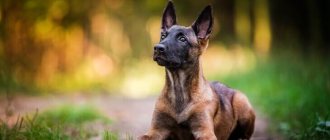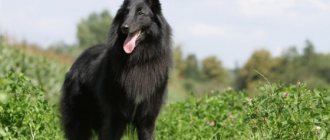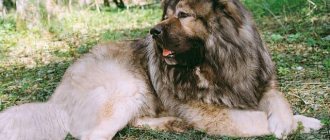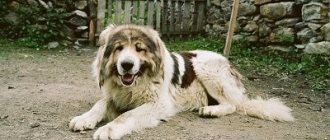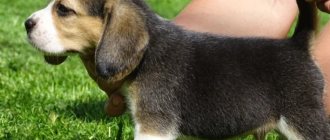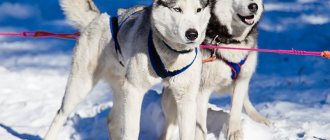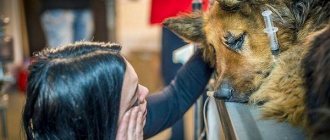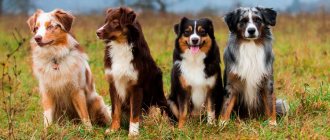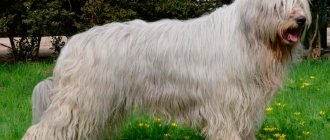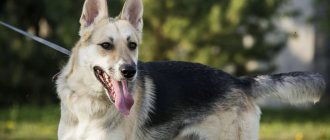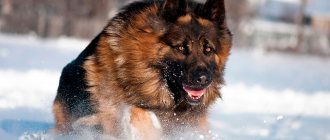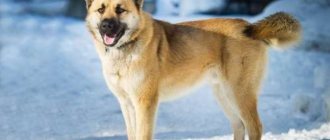Origin story
At the end of the 18th century in Belgium, all shepherd dogs were called shepherd dogs. The first club for the Belgian dog breed was created in 1891, and a year later the standard was formed. By this time, all Belgians were classified into the following varieties:
- long-haired;
- short-haired;
- Wire-haired.
Subsequently, each variety was given a unique name. The black dog with long thick hair was named Groenendael in honor of the cafe-restaurant of the same name. Wire-haired small representatives of the Laekenois breed in accordance with the name of the castle in the vicinity of Brussels. Long-haired dogs of various colors (with the exception of black) are called Belgian Tervuren in honor of the city of regional significance. The short-haired shepherd Malinois is named after another locality, Melekhen (pronounced “Maline” in French).
In accordance with the ICF classification, all 4 categories of dogs are combined into one breed. But in America, only the Belgian Black Groenendael is called a shepherd dog. Laekenois are not allowed to show. And the remaining two were transferred to separate breeds.
Despite their differences in appearance, all dogs have a similar character. They are kind and faithful, make excellent companions for lonely old people, and get along in families with children.
Training
As soon as the puppy appears in the house, the owner must establish proper contact with him. A positive outcome of training is ensured precisely from this period, since respect for the owner is the main thing that will guide his behavior in the future.
The correct response to basic commands will be the result of regular physical exercise and training only if the dog respects the owner. To do this, true friendship and respect must begin between them from the first contacts. Playing together, a moderately strict attitude, fair distribution of responsibilities, well-deserved praise are the principles of education that result in an obedient and competent animal.
Description of the breed
The main differences between the four categories are the length and color of the coat, which are the result of the work of breeders. Otherwise, the appearance and temperament of the dogs are no different. The Belgian breed has a powerful chest, a straight back, muscular limbs, and a belly that flows smoothly from the chest.
Belgian dogs have a strong neck. The muzzle is elongated, tapering towards the tip of the nose. The canines are white with a scissor bite. The eyes are large, the color of the iris is yellow-brown. The ears are set high, stand straight, and resemble a triangle. The tail is straight (if the dog is sitting or lying down) or curved in a semicircle when moving. The coat is thick with a soft undercoat.
Distinctive features
The main traits that determine a dog's thoroughbred:
- The body is powerful, has a rectangular shape, in females it can be slightly elongated in length. The muscles are well defined. The chest and back are wide. The upper part of the ribs is rounded, the lower part is elongated. The back is strong and level. The abdominal line is moderately tucked. The skin on the body does not form folds.
- The head is proportional to the body, strong, with a wide sloping forehead. The muzzle tapers towards the end, has a level bridge of the nose, moderately defined, muscular cheekbones.
- The ears are large, erect, triangular in shape, rounding towards the tips. Planted high and moderately wide. The back side is covered with dense wool.
- The eyes have a round shape, close to almond-shaped. Their color is brown. The more saturated the shade, the better. The eyes are expressive and shiny. The look is smart and inquisitive. The color of the eyelids is black.
- The nose has a classic shape. Its color can only be black.
- Large teeth The edges of the lips are black. The presence of spots and pink color is a disadvantage.
- The forelimbs are straight and distinguished by pronounced muscles. Elbows are directed parallel to the body. The withers are clearly visible, the shoulder blades slope forward.
- The hind legs are strong and strong, muscular. The joints form proportional angles, so that when looking at the dog, a feeling of “springiness” is created. The claws are dark and not wide. The presence of fifth fingers is not welcome. Usually they are removed.
- The tail is set high . When the dog arrives at rest, it is lowered down, only the tip remains raised to the height of the hock joints. If the animal is active, playing or working, the tail rises to the level of the back.
Types and colors
The historical development of the Belgian breed is associated with constant changes in the standard, the introduction or bans of certain colors. The final version of the breed description was approved in 1989. He divided all dogs into 4 types.
Crossing individuals of different categories is prohibited. The permit may be approved by the canine council in exceptional cases.
Laekenois
Dogs with rough hair. Her ancestors were representatives of the Dutch Shepherd and Bouvier des Flanders. The Laekenois is the least common type of Belgian breed and is mainly found in Belgium and the Netherlands. It is practically not represented in Russia. Dogs have a more docile nature than other varieties. Therefore, they are used not only for protection, but also as companions for lonely elderly people or disabled people.
Groenendael
Shepherd with long straight black hair. This color makes the dog mysterious and aristocratic. This variety of the Belgian breed has its own history. At the end of the 19th century, the owner of a small restaurant's dog brought a puppy with pure black fur. Having crossed him with a long-haired shepherd of a similar color, the owner became the owner of several babies, one of which, named Duc DE Groenendael, is considered the progenitor of all Groenendaels. Later, others began breeding dogs, but the name of the category remained unchanged.
Tervuren
The Tervuren or Great Dane looks like a Groenendael. But it has a different color: burgundy-red or fawn (white with darkening). The breeder of this variety of the Belgian breed is F. Korbel, who lived in the city of the same name. He held a male and a female, whose fur turned from red to black at the ends. Their puppy became the founder of the breed. This feature is now called charbonage and is a characteristic of the Tervuren.
Malinois
Malinki are short-haired dogs that are the most popular among Belgians. The red color of the Malinois is commonly called fawn color. The dogs have jet-black markings on their sides and a “mask” of the same color on their muzzle.
Dogs are regularly attracted to police and military personnel. Shepherd dogs are highly active, resilient and trainable. They successfully participate in Frisbee, agility and protective training competitions. Malinois do an excellent job as rescuers and search engines. The advantage of this breed is its short coat, which is much easier to care for. They are classified not as show dogs, but as working and sporting pets.
The Belgian Kerung (a system for identifying breeding dogs based on working criteria) and the “Belgian Ring” (sports testing) made it possible to preserve and improve the inherent performance qualities of the raspberry.
The Belgian Ring is a complex standard that requires special training. Only Malinois dogs can complete the program; other breeds cannot cope with the tasks.
Belgian line: history of origin
The Malinois is not a Belgian Shepherd. This is one of four breed lines of shepherd dogs from Belgium, bred in Mechelen. The Belgian Shepherd of any type has a lot of similarities with shepherds from Germany, that is, German, but at the same time they are a completely independent breed with bright characteristic features. “Belgians” were bred in Flemish, which is part of the country of the same name as the breed. However, the roots of this breed are international rather than exclusively Belgian. Cynological records from the 18th century indicate that aboriginal dogs lived on the border of Belgium and the modern Netherlands, which local shepherds domesticated and attracted to shepherd work.
"Belgian" guards the herd
Thus, Malinois were bred not only with the help of humans, but also with the assistance of nature. These shepherd dogs were created in a limited area, so the selection in this case can be called primitive. The first “Belgians” had close blood, a limited gene pool, and were similar to each other.
Later, at one of the exhibitions, when shepherds from different territories were looking for dogs for mating, the gene pool expanded a little, and new blood poured into the breed. At the same time, the first club was created, or more precisely, a small group of enthusiasts who appreciated the working qualities of the “Belgians”. Thanks to these people, Malinois developed rapidly: they were successfully bred without losing their characteristic features.
Belgian Shepherd puppy
An official Malinois kennel club, the first in the history of the breed, was created in 1898, and its members were included in the Belgian Shepherd Union. Three years later, in 1901, the participants included a beautiful red male named Vos des Polders in the club's stud book. The name of the animal was associated with its color: dogs with red hair at that time were often called Vos (translated as “fox, fox”).
The first fundamental breed sire, whose blood is still very valuable, was called Devet. It was a male born from Vos des Polders and a female Liske de Laeken. The dog had a rich fawn coloring with a blackened mask, and was by all accounts extremely handsome. This is one of the most famous producers, standing at the origins of the breed.
Fawn Malinois with black mask
However, the impeccable exterior of the Malinois brought practically no advantages and still does not bring any advantages to the breed. Breeders and owners of these dogs value other qualities: the character and working skills of the Belgians, which allow them to be versatile dogs. Malinois are used as guide dogs, shepherds, rescuers, security guards, police assistants, detection dogs, and they have a dozen other uses.
Belgium: Shepherd Dogs
At the end of the 19th century, shepherds of the Belgian territories developed a certain type of dog, indispensable when working with herds. These were vigilant, easily trained animals, with excellent watchdog qualities, unpretentious and very hardy. But they were not a breed in the generally accepted sense: the exterior, type and colors of their coat were too different.
The Belgian line of dogs began to be developed by Adolf Rühl, a professor at the Veterinary Academy, who became very interested in herding dogs that unquestioningly carry out the will of man. Having selected the most stately individuals, Ruhl began purebred breeding. It was he who formed the four types of “Belgians”.
Representatives of the Belgian dog line
The Belgian breed was recognized in 1897, and at the same time a large monobreed exhibition was organized, where more than a hundred representatives of the “Belgians” were present. Ruhl himself was present at the exhibition, selecting the most successful individuals for further selection. The first breed standard, which included all four types, appeared in the same years, but the standard was officially formalized only in 1910.
Note that in Russia only the Malinois is called the Belgian Shepherd, although in fact it is one of the four types of “Belgians”. The other three breeds are Laekenois (coarse short hair), Turvuren (long hair) and Groenendael (long black hair). In America, four of these breeds are recognized as independent, and the Russian Cynological Federation classifies them as one. But due to the small distribution in the country, the other three representatives of the Belgian Malinois line are considered the most famous and even classic “Belgians”.
Four "Belgians"
Despite the fact that all four varieties are very similar, only the Malinois fully possesses universal working, guarding and service qualities, a firm and direct character and is suitable for many variations of helping a person. The three other types of Belgian Shepherds are better known abroad as herding dogs and are unable to compete with the Malinois in working trials.
Malinois: how red-coal dogs appeared
Beautiful, lean dogs of the Belgian type bear the name of the city in the vicinity of which their history began - Belgian Malin. A certain Max Bernard lived in this city, who owned a male dog named Samlo. The male was bred with the dog of another city resident, and the couple gave birth to the famous male named Tommy, considered the very first purebred Malinois. The puppy was acquired by Monsieur Segherse, who then went down in history with his pet - mentions of this dog are still found in pedigree records to this day.
Malinois: on the left from 1904, on the right a modern dog
Tommy was later bred to a bitch named Cora, and from this mating, on which the breeders had high hopes, a puppy named Tjorp was obtained. When the dog grew up, it became clear that he was a reference dog. Tjorp is a representative of the breed, which is still considered by breeders to be closer to the modern type of dog. It is worth noting that the Malinois is a unique breed, since compared to other dogs it has undergone a minimal number of changes in its appearance, and today we can observe these animals almost in their original form. The photo above shows that the Malinois has retained the same exterior for more than a century.
Further, the breed experienced a decline - this was due to the difficult period between the two world wars. At this time, dogs were brought to the front, and they died in dozens, fighting side by side with their owners. After World War II, the breed continued to develop in Europe, and Malinois began to gain popularity again, especially in France and Belgium. The breed was revived as a police-sports and ring breed.
Malinois - the king of the sporting rings
Characteristics and standard
Shepherds are large, graceful dogs with thick bones. The head is medium with erect triangular ears, located on a powerful neck. The tip of the dog's nose is black, its eyes are almond and yellow-brown. Belgian Shepherds are proportionally built and have a balanced height to weight ratio. Mature males reach a height at the withers of 68 cm and a weight of 35 kg.
According to the ICF, shepherd dogs are classified as herding and cattle breeds.
Nurseries
In Russia, the breed is just gaining popularity, but Belgian Shepherd kennels are already operating in large cities. Purebred puppies can be purchased from:
- Moscow - “Line of Grace” https://liofgr.ucoz.ru, “From Solnik” https://www.solnik.ru;
- St. Petersburg - “Pearl of the North” https://hochusobaku.ru/kennel/3749/.
Belgians are loyal and hardy animals, very devoted to their owner. However, a dog will show positive qualities only with proper upbringing. She needs a self-confident leader - if you give him slack, the pet will grow up eccentric and uncontrollable.
Advantages and disadvantages
Advantages of Belgian dogs:
- good health;
- variety of colors;
- moderate care;
- fast learner.
But before buying a puppy, you should take into account that maintaining it will require time and financial costs. A shepherd dog must be socialized as early as possible, and an adult dog must be constantly trained, consolidating its skills. A Belgian Shepherd, left unattended by its owner, can cause a lot of trouble.
Character and appearance
Despite the difference in color and length of coat, all shepherd dogs have thick and smooth coat with a soft, dense undercoat. It helps the dog cope with different climatic conditions.
The Belgian's front legs are muscular and straight, arranged parallel. The pads are round, thick, the claws are strong and dark in color. Hind legs with strong thighs and shins.
The tail of the Belgian Pass is wide at the base with a curved tip. During activity, it should not fall on one side.
Bred as a herding breed, the Shepherd Dog is an energetic, attentive dog capable of self-assessment.
If a shepherd puppy is not introduced to other people and animals in time, he will grow up to be overly timid or aggressive.
Belgian Shepherds can be companions, guard dogs, or shepherds. They get along well with children and love to play with them. Usually they become attached only to the owner.
Despite the similarities, each type of shepherd has its own character traits:
- The Malinois is a born leader with strong guarding and herding qualities. Gambling dogs enjoy participating in competitions and relay races.
- Groenendael is an unpretentious type of shepherd dog, ready to complete any task. They are used for rescue operations.
- Laekenois is an easy-going and kind Belgian dog. He quickly learns commands and always obeys his owner.
- Tervuren is a born watchman and protector. Restrained temperament, responsibility and the ability to make independent decisions are the distinctive features of this type of shepherd dog.
Belgians are able to get along with dogs of other breeds and pets. It all depends on upbringing and training. Instincts force the shepherd to chase other animals, especially cats. But a dog that grew up in the same territory with such an animal will treat it much more tolerantly.
Psychological portrait of the breed, character
A high level of intelligence, responsiveness, great affection for the handler or owner, the highest diligence and amazing performance, incredible energy that overflows - all this is about the Malinois. The working qualities inherent in these lean handsome men need no introduction. Representatives of the breed can be found in rescue services, in police and customs departments, as well as among dogs specializing in searching for drugs, explosives, and missing people.
“Belgians” are irreplaceable in cynological and social structures around the world
Another aspect where the Malinois has no equal is all kinds of sports rings. Dogs successfully show their talents in training demonstrations, work in agility, IPO, obedience, mondjoring, RR (Russian ring), freestyle (dancing with dogs) and similar disciplines.
How are agility competitions held? Where in Russia can you learn agility and how to start training? More details in a special article.
Talents of the Belgian Shepherd
As we have already found out, the Malinois can work in almost any field. The unique nervous system of this breed allows them to easily adapt to solve a variety of problems. It is important to focus on teaching your dog specific actions from a very early age.
Malinois are considered excellent jumpers, capable of clearing hurdles up to three meters in height. These animals are excellent swimmers, have a strong grip and quick reaction. “Belgians” are not only excellent at training, but also enjoy their work. Therefore, the breed is included in the list of highly specialized ones and is not suitable for a person who does not have experience in canine sports or is not an employee of the special services.
Malinois is not needed by an amateur
Table 2. Sports and rings for Malinois
| Name | Description |
| IPO | An international system that involves testing dogs in three areas: protection, tracking and obedience. |
| Mondioring | A difficult discipline that combines elements of the best protective sports with dogs. The animal's goal is to practice jumping, protection and obedience. |
| Frisbee dog | The dog must catch the maximum number of discs thrown by the handler. Speed, agility, accuracy, jump height are assessed |
| Obidience | Dog training aimed at general disciplinary training |
| Agility | Competitions in which the dog must pass an obstacle course (barriers, stairs, snake, boom, tunnels, etc.) as accurately and quickly as possible. |
| Freestyle | Discipline that combines obedience and grace of an animal. Together with the handler, the dog must show the number as effectively as possible to the music |
| OKD | The discipline “General training course”, in which the obedience skills of an animal are tested. The dog must complete a set of commands, gaining the maximum number of points |
| Russian ring | Competitions assessing defensive skills. During them, the dog's general obedience is tested, as well as its ability to protect itself, its handler or things from one, two or three attackers. |
| ZKS | The program called “Protective Guard Service” is aimed at developing guard skills, guard and escort qualities, and guard skills in animals. |
Belgian Shepherd participating in Mondioring
Of course, the Malinois is an excellent companion, a pet and a person’s partner in all his endeavors. Malinois are well trained, become attached to family members, and are unpretentious in their maintenance. But the breed is not suitable for a beginner: the owner of the “raspberry” must be correct, not allow excessive tenderness with the animal, be fair, but strict. The Malinois needs constant exercise and exercise for the brain and body.
This hardy breed is designed to serve man and suffers without work, and also becomes a source of considerable problems. Without the necessary stress, the dog will begin to destroy the apartment or “disassemble” its own enclosure, and will become aggressive, uncontrollable and even dangerous. The owner must always remember this and calculate his strength when choosing a pet.
Lack of attention will make the dog unhappy
Main features of the breed:
- high level activity;
- vigilance;
- wariness of strangers;
- high intelligence;
- self confidence;
- pronounced qualities of a security guard;
- hard work.
Video – Russian ring, Malinois
Training and education
When purchasing a puppy, the owner must be prepared for the fact that a curious baby will actively explore the territory. It is necessary to remove in advance all objects that are dangerous for the puppy, as well as valuable things that the animal can spoil. If the owner intends to accustom the Malinois to a crate, this must be done from the very first day the puppy arrives at home.
You must immediately purchase a crate of such a size that an adult dog can stand there at full height without any problems and can comfortably lie down, stretch out, turn around while standing or sitting. A soft bed is placed in the cage, bowls of water are secured, you can create additional comfort for the animal and throw a cover over the cage, hiding the animal from prying eyes.
It's easy to crate train a puppy
If you feed the baby inside the crate, offer him toys, do not force him inside and do not leave him locked for a long time at first, then very soon the dog will perceive the crate as his den and will sleep in it without any problems while the owner is away from home.
As for toys, both a puppy and an adult dog need them. Young “Belgians” have a strong instinct to try everything. Of course, shoes, household and interior items are not suitable for this, but if you replace prohibited things with permitted toys, in a couple of days the baby will understand how to behave.
The puppy must have enough toys
It is important to consider that Malinois are prone to making independent decisions, as their instincts are strong. Yes, the “Belgian” will be loyal to all family members, but if they are in danger, he may not wait for the owner’s command and decide on his own that it’s time to come to the rescue. Therefore, the owner of the Malinois must be vigilant and do not remove the muzzle from the animal in crowded places. The Malinois must be accustomed to this accessory from the age of three months.
As soon as the puppy has adapted to the home, got used to the person and accepts his nickname, it’s time to enroll the baby in group general training classes. This is a basic course: every Belgian must first learn to obey commands unquestioningly before going out to work in defense or trying himself in any sport.
Many breeders begin training puppies before they are sold.
In addition to perfect obedience, the Malinois must be well socialized. To prevent the dog from becoming aggressive (territorial and interspecific aggression is especially dangerous). From an early age you need to show the animal as much as possible new things. You need to take the puppy with you everywhere, carry it in the car and on public transport, appear with it in crowded places, and introduce it to other dogs.
How to carry a dog in a car?
Maintenance and care
A distinctive feature of the Belgian Shepherd is its thick and coarse coat, which protects it from getting wet. During shedding (summer and winter), the short, soft undercoat combines with long hairs, creating tangles that are impossible to untangle. To avoid this, you will have to brush your dog daily.
Breeders advise cutting the hair between the toes, since when it rolls down, it provokes lameness and inflammation.
Expert opinion
Anna Abramenko
An avid dog lover. Experience in veterinary medicine since 2009.
Ask a Question
Like all dogs, the shepherd needs to brush its teeth, ears, wash its eyes and trim its nails once a week.
Belgian Shepherds are working dogs bred to help shepherds. Therefore, they need systematic physical exercise and a feeling of need. It is worth entrusting your pet with work, no matter what. Lack of attention and physical activity spoil the character of dogs. They bark for no reason, dig holes or run away.
Shepherd dogs can patrol the garden area, control order in the yard, and guard the house. They require open space to exercise.
Upbringing
The Belgian breed is easy to train. Competent training, a strict (but not cruel) owner, coordination of boundaries are the key to successful training. Sheepdogs are not similar to the Malaysian Telomian. Without early socialization, they will be wary of strangers and will not follow commands.
Cynologists advise when training:
- use a muzzle during the first lessons;
- refuse loud shouts and physical punishment; a sharp tug on the leash is allowed;
- give the dog enough attention;
- do not make a fuss in front of the pet, as it reacts to the mood of the owner and his family members;
- if the shepherd dog is not involved in service, it should be provided with another occupation - participation in relay races or guarding the local area.
Expert opinion
Anna Abramenko
An avid dog lover. Experience in veterinary medicine since 2009.
Ask a Question
When a pet barks at passing vehicles, chases cats and jumps on passersby, trying to bite, this indicates improper training. Therefore, the upbringing and socialization of a puppy should begin as early as possible.
Attitude towards children and others
Speaking about the Malinois breed, experts pay attention to their clear distinction between those around them as “friends” and strangers. For the Belgian, the owner’s family is an object of protection. He will express his devotion and care to them in every possible way, and protect them from any danger. If a stranger appears in the immediate environment, the Malinois will have enough endurance to observe him from afar. However, at the slightest sign of aggression from an outsider, the shepherd will immediately rush into battle.
The same can be said about the dog’s desire to carry out the owner’s instructions. She especially loves the role of watchman. When guarding a plot or house, the Malinois will be a model of responsibility and conscientiousness.
Today, Belgian women are increasingly being bought into families for teenagers. And not in vain. They are wonderful friends, sociable and active partners. They will take part in games, show their sympathies, but will not forget about their main function: to protect the children of their owners from the slightest danger.
This breed of dog does not have much friendship with younger children. But they are indispensable assistants in supervision and protection from strangers. The dog will not harm the baby, but allowing itself to be pulled by the tail is beyond its strength.
Nutrition of Belgian Shepherds
The Belgian diet should be varied. A balanced menu is necessary for the following characteristics:
- Growth and development. Protein, which is found in meat, fish, eggs, milk and dairy products, will help with this.
- Obtaining energy, the source of which is carbohydrates: cereals and baked goods.
- Building muscle mass. You need fats, which are abundant in lard, butter and sunflower oils.
If your pet eats natural foods, you should include special supplements containing vitamins and minerals in the menu. They are necessary for the proper functioning of the dog's body.
It is forbidden to overfeed a shepherd. Obesity provokes the development of cardiovascular diseases, disruption of the kidneys, liver and stomach. Constant consumption of bones or fatty foods leads to allergies.
The pet should be fed at a strictly designated time.
When using ready-made food, it is recommended to choose it from the “super premium” or “holistic” classes. Cheap varieties can cause flatulence and metabolic disorders in dogs.
Diseases and life expectancy
The Belgian breed is distinguished by excellent health; with proper care, the pet lives from 12 to 15 years. Like many large dogs, shepherds suffer from the following diseases:
- hip and elbow dysplasia;
- volvulus;
- histamine (allergic) reactions;
- cataract;
- epilepsy.
With a lack of sports training, Belgian Shepherds develop obesity, which negatively affects not only their physical, but also their mental state. And due to uncontrolled activity, the risk of paw injury increases.
It is important for your dog's health to follow the vaccination schedule.
Health
Belgian Shepherds have good health - with proper care and good heredity, dogs rarely have problems. Many representatives of the breed live to old age, maintaining a sharp mind and high physical activity. On average, a pet of this breed lives 10-12 years.
The recorded record of longevity among Belgians is 18 years and 3 months.
Diseases
Belgian Shepherds, like all large dogs, have joint problems. Animals older than one year must be photographed to determine the extent of the disease.
Belgians are also more likely than other breeds to suffer from the following ailments:
- epilepsy;
- Aujeszky's disease;
- retinal atrophy;
- cataract;
- gastric volvulus;
- cancer.
Dogs also have problems with the thyroid gland, hemophilia, osteochondrosis, and infertility. Belgian Laekenois are most susceptible to these diseases, since during selection, breeders crossed closely related individuals.
To protect your Belgian Shepherd from diseases, you need to provide it with proper care and a balanced diet, regularly show it to the veterinarian, and carry out routine vaccinations.
Vaccinations
Puppies are kept breastfed for up to 8 weeks. At this time, passive immunity is formed in animals, which protects the dog from diseases. When the amount of antibodies in the blood decreases, pets are vaccinated against:
- rabies;
- infectious hepatitis;
- parainfluenza;
- leptospirosis;
- carnivore plague;
- herpesvirus.
At 6 months, Belgian Shepherds are given a second rabies injection.
In the future, dogs are annually given vaccines against these diseases. Also, once every 3 months, pets are treated for parasites.
Choosing a puppy
Before buying, you should visit exhibitions, read reviews from owners, and study the peculiarities of keeping the breed. It is better to buy a baby from a trusted nursery that values its reputation.
Expert opinion
Anna Abramenko
An avid dog lover. Experience in veterinary medicine since 2009.
Ask a Question
Before purchasing a shepherd, it is recommended to study the pedigrees of its parents and see the dogs in person.
Some nurseries test the behavior of Belgian Shepherd Malinois or Groenendael puppies to determine the character traits of each baby. Before purchasing, you should familiarize yourself with the test results.
A healthy dog is moderately well-fed and very active. The eyes and nose are moist, there is no discharge or unpleasant odor. The owners of the nursery will tell you about the rules of education, training and feeding. They will note the temperamental features of the puppy they like.
Video
* We invite you to watch a video about the Belgian Shepherd . In fact, in front of you is a playlist in which you can select and watch any of 20 videos about a given dog breed by simply clicking on the button in the upper right corner of the window. In addition, the material contains quite a lot of photos. By looking at them you can find out what a Belgian Shepherd looks like.
In this article:
|
Rate the material!
[Total votes: 0 Average: 0]
The Belgian Shepherd is an intellectually developed and very active dog that vitally needs constant physical activity and an interesting activity or work. This breed is suitable only for those who live a busy life, are constantly on the move and are ready for active interaction with their pet. Belgians have many similar characteristics to German Shepherds, but they are a completely independent breed with their own characteristics.
Interesting Facts
Belgian Shepherds serve in the police as bloodhounds or guards. The collaboration between shepherd dogs and law enforcement began at the end of the 19th century. It was initiated by the Commissioner of the City Police Department (Ghent, Belgium) Edward vom Wezemail. He was the first to create a canine service, choosing the Malinois.
They began special training with three dogs, and by the end of the year their number increased to 10. The Commissioner covered in the local press the successes of using shepherd dogs in the service, which allowed not only to increase interest in the Belgian breed, but also to interest a number of European countries in their use. Just 5 years later, police patrols with Malinois could be found on the streets of France and the Netherlands.
Reviews
Reviews from owners of Belgian shepherd dogs will help you get to know these animals better, learn their character traits and content.
Nikolay, Penza: “My Groenendael is a unique dog with a deep look and sensitive perception. Sometimes it seems to me that his activity is enough for three. He's just a ball of energy. There are no barriers for him. Consider the shepherd's superpower to pluck apples straight from the branches. It is not safe to leave your dog unattended. That's why I gave him to a professional trainer when he was still a puppy. 5 months were enough for us to master all the basic commands. No special skills were taught, but the dog independently took upon himself the responsibility of guarding the house and yard.”
Sergey Vasilievich, Nizhny Novgorod: “I am a Malinois fan. I already have a third dog. Therefore, I responsibly declare: if you have no experience in keeping large breed dogs, do not start with the Belgian breed. Raising such a dog is daily painstaking work and great responsibility. You will have to walk with your pet in the fresh air for 2-3 hours every day, run and train it. Keeping a shepherd dog requires a lot of time and money. They are only suitable for true dog lovers.”
Irina, Novosibirsk: “The character of a Belgian dog directly depends on the correct upbringing and training. Our favorite has completed a full course of training from a professional trainer. And you couldn't find better security. The shepherd thoroughly studies everyone who comes into the yard, and is ready to protect “members of his family” from any ill-wishers. This is the most faithful and devoted dog of all who lived with us. Sometimes it seems to me that the dog understands me without words. A gesture or a glance is enough.”
Belgian Shepherds are not couch dogs. These shepherd dogs need the “steady hand” of the owner and completion of a professional training course. With proper upbringing and care, the puppy grows up to be an intelligent, loyal animal that will become a true friend.
Socialization
A Belgian Shepherd puppy begins to be socialized as early as possible, otherwise the pet will grow up uncontrollable and will not be able to adequately interact with the outside world. A couple of days after the baby appears in the house, they take him outside, introduce him to relatives and other people, and accustom him to the noise of the city. The dog must learn the rules of residence, know when it is possible to play, and when it is better not to disturb the owners.
The Belgian Shepherd dog breed requires professional training. If the owner has little experience, it is better to give the puppy to a dog handler who can raise him properly.
Belgian Shepherds are highly trainable and remember commands right away. But we cannot stop there. The acquired skills need to be constantly reinforced, so they continue to work with the pet even after it has completed a basic training course. Treats are used as reward. The pet is also generously praised for any action performed correctly.
Dogs of this breed do not tolerate rough treatment - the owner needs to be persistent, but patient. To show your pet that he is doing something wrong, it is enough to change the intonation to a rude one, or, in extreme cases, pull the leash. If you don’t plan to raise your pet into a service dog, you should find something else for him to do. An agility course is perfect for these purposes.
An untrained Belgian Shepherd is dangerous to others. Such a dog does not know how to analyze current events, which is why it can rush at a person if there is an imaginary threat.
Belgian Shepherds easily find contact with other pets if the owner pays enough attention to the dog. But in relation to small animals, a manifestation of the hunting instinct is possible. It is better if four-legged friends meet in childhood.
The Belgian Shepherd will selflessly protect the child, but will not tolerate disrespectful treatment. A well-mannered pet will not injure the baby, but will not play with him either. The dog will be more interesting with teenagers - you can run with them and frolic in the fresh air. To avoid misunderstandings between the Belgian and children, they should be told in advance about the rules of behavior with animals and dog body language.
Photo and video review
In the video, the breeder will tell you in detail about the rules of care and maintenance of the Belgian shepherd breed. And the photos presented will help you get to know each variety better.
